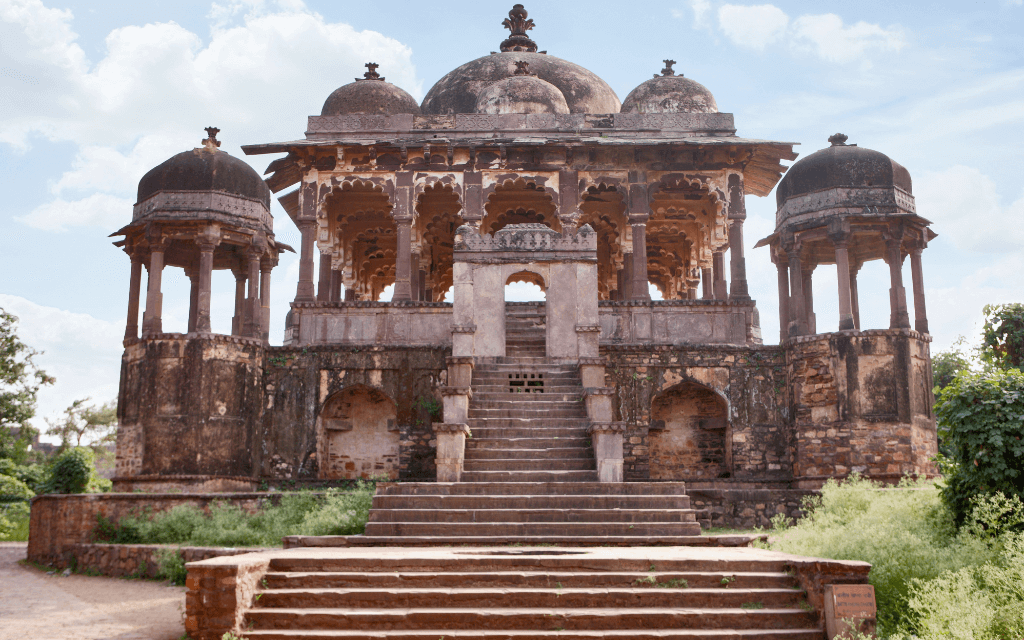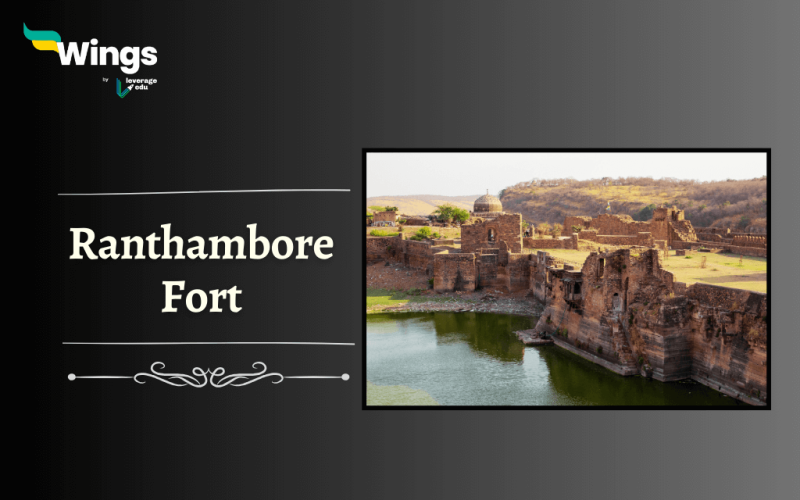Ranthambore Fort is situated right in the heart of the Ranthambore National Park in Sawai Madhopur city of Rajasthan, India. This magnificent fort has witnessed centuries of history, from the rule of Chauhans to the Mughals and its place in independent India. This formidable fort, which dates back to the 5th century, has witnessed the rise and fall of empires, battles fought and won, and rulers who have left their mark on its magnificent walls. Let’s delve into the Ranthambore fort history, features, facts and more information about the fort.
Contents
History of Ranthambore Fort
The fort is believed to have been built by the initial ruler of Rajasthan, King Sapaldaksha. Initially, the name of the fort was “Ranath Bhawar Garh”, which meant the place of the Rajput warriors.
- Ancient Origins: Built in 944 AD by the Chauhan Rajput rulers, Ranthambore Fort was initially a humble hill fort. Over the centuries, it evolved into this stronghold. However, some believe the fort was built by King Jayanta in 1110 AD, which is still contested.
- Chauhan Dynasty: The fort served as a strategic centre for the rulers, allowing them to control trade routes and protect their kingdom. For a brief period of time, the fort also belonged to Muhammad Ghori in the year 1192, when Prithviraj Chauhan was defeated in the Second Battle of Tarain, but the Chauhans recaptured the fort.
- By the 15th century, many rulers like Illtutmish, Balban, Ala-ud-din Khilji, etc besieged the fort for a short time.
- Rajputs Rule: Ultimately, the fort went to Hada Rajputs of Bundi, during the reign of Rana Udai Singh I passing from the hand of Rana Hamir Sungh, Rana Kumbha and Rana Sanga from Mewar.
- Mughal Influence: In the 16th century, Ranthambore Fort fell into the hands of the Mughal Empire under Emperor Akbar. The fort underwent significant renovations and became a symbol of Mughal power in Rajasthan.
- Jaipur Rule: At the end of the 17th century, the Kachwaha Maharajas of Jaipur retained the fort themselves and became a hunting spot for the rulers. When India gained its independence in 1947, the fort became part of Independent India.

| Commissioned by | Chauhan Ruler |
| Location | Sawai Madhopur, Rajasthan |
| Timings | 6:00 am to 6:00 pm; open everyday |
| Entry Fee for Fort | ₹ 15 for Adults; ₹ 10 for Children |
| Camera | Both Still and Video Camera are allowed |
| Status | UNESCO World Heritage Site |
Also Read – Neemrana Fort History: Features, Facts, Timings & More
Features of Ranthambore Fort
The formidable walls of the fort, towering over 700 feet above sea level, its impregnable and strategically significant because of its features. Some of them are –
| Features | Description |
Architecture | Ranthambore Fort showcases a blend of Rajput and Mughal architectural styles, with intricately carved temples, palaces and gates. |
| Dhula Mahal, the fort houses Bada Mahal, Phansi Ghar and Hammir Court. Other attraction inside the fort includes Sametonki Haveli, Mahadeo Chhatri, and Toran Dwar. | |
Temples | Within the fort complex, there are ancient temples dedicated to Hindu deities such as Ganesh, Shiva, and Ramlalaji. |
| The temple of Ganesh is one of the oldest temples in India and is built with Karauli stone. | |
Gates | One of the most famous entrances to Ranthambore Fort is Ganesh Pol, a grand gateway adorned with intricate carvings and sculptures. |
| Along with these, there are other elegant gates, namely, Navlakha Pol, Hathi Pol, Andheri Pol, Sat Pol, Suraj Pol, and Delhi Pol. | |
Water Management | Ranthambore Fort boasts a sophisticated water management system comprising tanks, reservoirs and step wells. This ingenious system ensured a stable water supply for the fort’s inhabitants during times of siege. |
Stories and Legends of Ranthambore Fort
Ranthambore Fort isn’t just stone and walls—it holds centuries of tales filled with valour, faith, and legacy. Here are some of the famous legend stories that you will hear about Rathambore Fort:
The Heroic Defence by Hammir Dev Chauhan
One of the most iconic legends is the brave stand by Hammir Dev Chauhan, the last Chauhan ruler of Ranthambore. Despite facing a powerful attack from Alauddin Khilji in the 14th century, Hammir chose to fight with unmatched courage rather than surrender. His resistance is still remembered as a symbol of Rajput bravery.
A Tale of Loyalty, Betrayal, and Sacrifice
The fort has seen tales of deep loyalty and tragic betrayal. Legends say trusted allies turned enemies, leading to fierce battles and massive sacrifices. These stories echo through the fort’s walls and corridors, leaving a haunting yet heroic imprint on its history.
Beliefs Around Trinetra Ganesh Temple
One of the most visited spots inside the fort is the Trinetra Ganesh Temple, believed to be one of the oldest Ganesha temples in India. Local belief holds that Lord Ganesha appeared in King Hammir’s dream during a siege, promising protection. Even today, people send wedding invitations to the temple, seeking blessings before major life events.
Facts about Ranthambore Fort
Rathambore Fort represents the history and significance of this place. Many facts about this fort have amazed people for years. Here are some of the facts about Ranthambore Fort that you should also know.
- UNESCO World Heritage Site
Ranthambore Fort is part of the UNESCO World Heritage Site “Hill Forts of Rajasthan” for its historical importance and Rajput military architecture. - Built in the 10th Century
The fort was originally built by the Chauhan rulers, likely around 944 A.D., making it over 1,000 years old. - Strategic Location
Perched on a hilltop at 700 feet above the surrounding plain, the fort offered a perfect defense view and control over trade routes. - Ruled by Several Dynasties
Ranthambore Fort was ruled by Chauhans, Delhi Sultanate, Mughals, and the Jaipur royal family over the centuries, reflecting a mix of cultural influences. - Inside Ranthambore National Park
The fort is located inside Ranthambore National Park, one of India’s top tiger reserves, offering a rare mix of wildlife and history. - Temples Inside the Fort
It houses several temples dedicated to Ganesh, Shiva, and Ramlalji, attracting both tourists and pilgrims year-round. - Famous Ganesh Temple
The Trinetra Ganesh Temple inside the fort is one of the oldest temples of Lord Ganesha in Rajasthan and is visited daily by devotees. - Resisted Many Attacks
The fort was known for its strong defences. It withstood attacks by powerful rulers, including Alauddin Khilji, who finally captured it in 1301. - Inspiring Rajput Valour
Hammir Dev Chauhan, a brave Rajput king, is remembered for his heroic defence of the fort against Alauddin Khilji’s forces. - Panoramic Views
From the top of the fort, you can have wide views of lakes, forests, and the national park—a major draw for photographers and nature lovers.
Timings and Entry Fee of Ranthambore Fort
While visiting Ranthambore Fort, you have to follow the timings given by the authority along with a small fee. The timings for visiting the Monument and watching the mesmerising scene are:
| Detail | Information |
|---|---|
| Fort Opening Hours | 6:00 AM – 6:00 PM (Daily) |
| Best Visiting Hours | Early morning or late afternoon |
| Entry Fee (Indians) | ₹15 per person |
| Entry Fee (Foreigners) | ₹200 per person |
| Camera Charges | Additional ₹100 (still camera) |
| Guided Tour Availability | Yes, available at extra charge |
Best Time to Visit
The ideal time to visit Ranthambore Fort is between October and March, when the weather is cool and pleasant. This period is also best for combining your visit with a Ranthambore National Park safari.
Combine with Ranthambore Safari
Don’t miss the chance to enjoy a wildlife safari at Ranthambore National Park, which is just nearby. Morning and evening safari slots are available, and you might spot tigers, leopards, and other wildlife in their natural habitat.
Also Read- Naldurg Fort History: Features, Facts, Timings & More
Other Attractions near Ranthambore Fort
Apart from Rathambore Fort, you can explore other hidden gems around this palace. Here are some of the other attractions near Ranthambore Fort:
- Ranthambore National Park
- Ranthambore School of Art Society
- Padam Talao
- Jogi Mahal
- Badal Mahal
- Amreshwar Mahadev Temple
Ranthambore Fort is a majestic structure perched atop a hill, and access to a beautiful sunset point. The fort holds within its walls centuries of history and war cries, though, in ruins now, it is a treasure trove of stories waiting to be told, simultaneously offering a glimpse into the glorious past of Rajasthan.
FAQs
Ranthambore Fort was built in the 10th century by the Chauhan rulers. It became famous for its strategic importance and the bravery of Rajput king Hammir Dev, who defended it fiercely against Alauddin Khilji.
The Trinetra Ganesh Temple inside the fort is believed to be one of the oldest temples of Lord Ganesha. Devotees believe the deity miraculously appeared during a war, and the temple now receives thousands of letters daily.
The fort was attacked several times, most notably by Sultan Alauddin Khilji in 1301. He launched a massive siege against Rajput ruler Hammir Dev Chauhan to expand his empire into Rajasthan.
The most renowned king of Ranthambore Fort was Hammir Dev Chauhan. He ruled with courage and pride and is remembered for his valiant stand against Sultan Alauddin Khilji’s powerful army.
Ranthambore Fort is famous for its blend of history, wildlife, and religious heritage. Located inside a tiger reserve, it attracts tourists for its stunning views, Ganesh temple, and stories of Rajput bravery.
Relevant Blogs
| Janjira Fort History | Amer Fort History |
| Kumbhalgarh Fort History | History of Fatehpur Sikri |
| Jaisalmer Fort History | Rajgad Fort History |
| Red Fort History | Harihar Fort History |
That’s all about Ranthambore Fort history! If you want to know more about topics like this, then visit our general knowledge page! Alternatively, you can also read our blog on general knowledge for competitive exams!
 One app for all your study abroad needs
One app for all your study abroad needs














